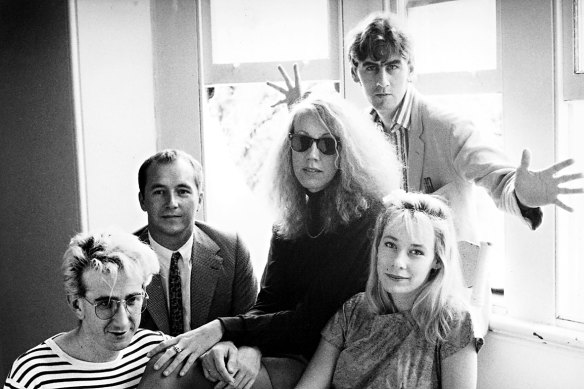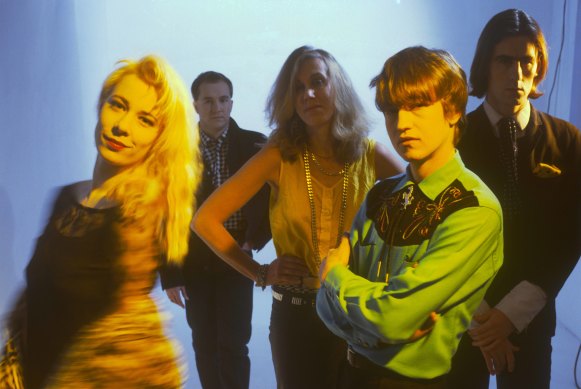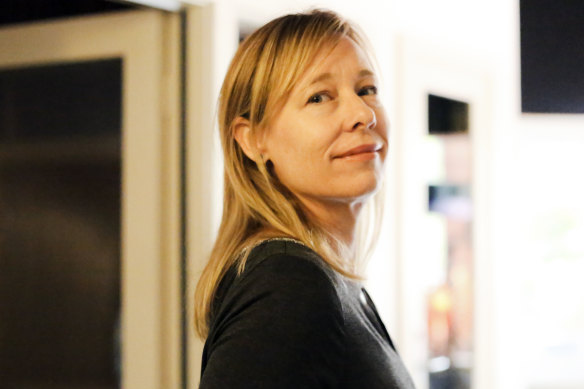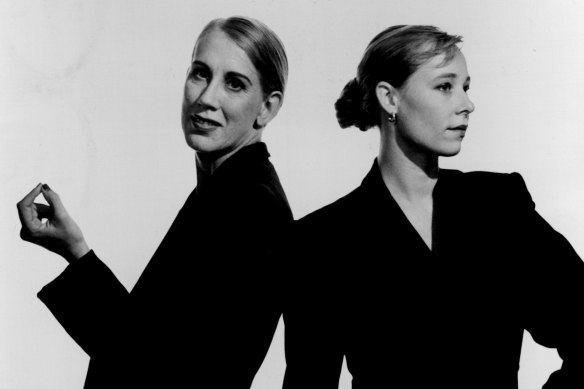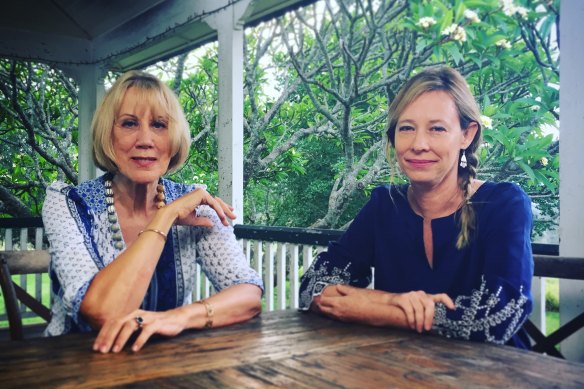By Michael Dwyer
The Go-Betweens circa 1988: from left to right, John Willsteed, Grant McLennan, Lindy Morrison, Robert Forster and Amanda Brown.
Amanda Brown from the Go-Betweens is bemused about being “Amanda Brown from the Go-Betweens”. It’s 33 years since the fateful morning her tenure was terminated by Grant McLennan, at precisely the same pre-arranged moment co-founder Robert Forster was telling drummer Lindy Morrison that she, too, was surplus to requirements.
It was a misjudged and painful moment for all concerned. The immense personal and professional ramifications have been much dissected since, as the beloved band from Brisbane, its final incarnation tragically halted by McLennan’s death in 2006, continues to forge a legend way beyond its humble successes.
The Go-Betweens, from left, Amanda Brown, Grant McLennan, Lindy Morrison, Robert Vickers and Robert Forster.Credit:Peter Anderson
“This was a band that never had a hit and never had a huge audience,” says Brown, who joined on multiple instruments in 1986 to the conspicuous advantage of classic albums Tallulah and 16 Lovers Lane. “We were always that sort of middle-tier, independent college/ indie type band.
“It’s funny because when I joined… I really noticed the inherent self-confidence that they had in their own historical importance. It struck me as quite arrogant… but it has actually turned out to be the case. People remember the Go-Betweens with a growing fondness across the generations and that is really quite remarkable.”
To put it in perspective, she adds, she was in that little band for four years. “I’ve been doing film music for 22 years. Admittedly, it’s taken a long time to build up a career in that area for various reasons of inherent misogyny,” she said. But since her scores for Babyteeth and Brazen Hussies scooped the AACTA Awards in 2020, “I feel like I’ve finally become established.”
Established enough, ironically, to dip back into a world she quite deliberately left behind. Eight Guitars is her first album as a singer and songwriter since Cleopatra Wong, the short-lived pop duo she formed with Morrison in the immediate aftermath of the Go-Betweens’ collapse.
Assembled over 20 years, the album title refers to the eight distinctive guitarists invited to embellish the tracks, among them Kirin J Callinan, Shane O’Mara and Brendan Gallagher. But for all the modest deflection of the title, it’s Brown’s songs, sung in a seasoned, assured voice with atmospheric arrangements, that direct attention.
Amanda Brown: “I don’t mind telling you that for years and years, Lindy and I did feel very erased from the story.″Credit:Lisa Businovski
“I realise as I’m talking about them how influenced they are by working in film,” she says. Trouble You’re In was inspired by watching Rob Epstein and Jeffrey Friedman’s 2013 biopic Lovelace. Light Lingers On, co-written with Steve Kilbey, was left over from one of her earliest soundtrack commissions, Look Both Ways.
More subtly, “I was trying to tell a story with each song… and also just conscious of that inexplicable synergy that happens when music and image work together really beautifully and something magic clicks into place. Which is why in all of the songs there are such long instrumentals. That comes from that film-scoring background, as well as a desire to highlight each guest guitarist.”
Lindy Morrison and Amanda Brown in Cleopatra Wong, in 1993.
Her own stated reticence as a front-person is no doubt another factor in the mix. As “a postmenopausal woman… I don’t over-analyse and just get on with it” she declared last month, as she announced her return as the singer-songwriter she never wanted to be.
“I’m kind of embarrassed about the Cleopatra Wong stuff now,” she says with a laugh. “I hate the sound of my voice on those recordings… they were the first songs I ever wrote, so for them to be out in the world is mildly embarrassing.”
She and Morrison were both raising small children at the time. The music industry of the early ’90s wasn’t geared for the touring inconveniences that entailed, although Brown did enjoy one last, epic shot at rock’n’roll glory when REM invited her to play violin, oboe and other things in stadiums around the world.
“Who would not love that experience?” she hoots. “It was fantastic.” But by then she was in the midst of tertiary music studies back in Sydney – her first formal education since leaving high school to study ballet. Her degree in composition from the Australian Film and Television School sealed a conscious resolve to leave the pop world behind.
“I guess the predominant reason was that I realised there were really no role models for women singer-songwriters of a certain age back then, and arguably not even now,” she says. “So I could see that the life of a singer-songwriter working in popular song had an incredibly limited tenure.”
There’s more irony here, as the aforementioned Go-Betweens legend evolves into a slow-burning feminist fable for a changing music industry. Robert Forster’s memoir of 2016, Grant & I, has copped its share of criticism for what Brown delicately calls a “glaring omission”. English singer Tracey Thorn’s subsequent book My Rock’n’Roll Friend addressed it head-on by celebrating the seismic inspiration she drew from Lindy Morrison.
Lindy Morrison (left) and Amanda Brown in The Go-Betweens: Right Here.Credit:Essential Media
“I don’t mind telling you that for years and years, Lindy and I did feel very erased from the story,” Brown says. “We weren’t going to be in that documentary [The Go-Betweens: Right Here, in 2017]. It was originally going to be an adaptation of Robert’s book and the ABC, who commissioned it, insisted that Lindy and I be involved and interviewed.
“So yes, it’s really interesting to see how things have happened… I think it’s analogous to the way that women in general are being more visible in the music industry now. And that’s probably a societal thing. It’s women moving into roles that we’d previously not occupied. Perhaps we have the #metoo movement to thank for speeding things up.”
Today, Brown is back at work scoring Deadloch, “a feminist noir comedy” by Kate McCartney and Kate McLennan shot in Tasmania. Eight Guitars will “come to fruition” with a show at the City Recital Hall in Sydney in June, with seven of the eight featured musicians appearing. It’s a show Brown would love to tour more widely, offers and logistics allowing.
“I much prefer to be a musician backing someone else,” she says. “I just thought, ‘Wouldn’t it be nice to have a gang of guitarists?’ So this is a dream, really.”
Eight Guitars is available at bandcamp.com.
A cultural guide to going out and loving your city. Sign up to our Culture Fix newsletter here.
Most Viewed in Culture
Source: Read Full Article
